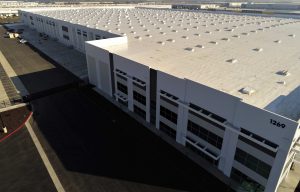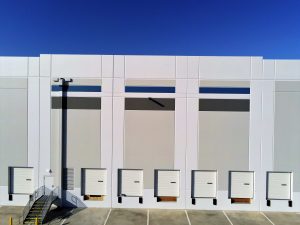Turn to Custom Painting, Inc. to have your commercial property repainted. Founded in 1982, we are a full-service residential and commercial painting company servicing cities in the San Francisco Bay Area. We are licensed, bonded, and insured. Our team includes both full-time professional painters and carpenters.
Once again, we used our expertise and several years of experience on a recent commercial project at the IPT-4 Grantline warehouse in Tracy, CA.
The warehouse was about 600,000 square feet, and our paint crew had to paint its interiors and exteriors. Due to the size of the space, the job took around three months to complete. Our paint crew used an estimated 3,000 gallons of elastomeric paint for necessary waterproofing.
Despite the challenges we met, we completed the project to our customer’s satisfaction.
Issues and challenges during the project
The project at IPT-4 Grantline Tracy Warehouse presented several issues and challenges, such as:
1) High walls – The warehouse had high walls. The lower portion of the wall alone, which measured 10 feet, needed more prep work than the upper portion before we could finish painting.
We did prep work on that portion. After the prep work, we moved to the upper part of the walls to paint them. Then, we had to come back to paint the lower portion.
We couldn’t paint from the ceiling down to the floor. Thus, a visible transition line between the upper and lower sections was visible. So, we needed to apply another coat of paint to make the transition more even.
2) Waterproofing – Waterproofing is often necessary, especially for painting factories, warehouses, and facilities.
We chose Sherwin Williams Sherlastic elastomeric paint for this project. Our paint crew carefully followed the manufacturer’s recommendations to apply the coating correctly. They also made sure that they reached the total recommended mil – or thickness – for the paint the work as it was intended to work.
3) Safe painting – To make our painting process as safe as possible, we used wash-out barrels to avoid environmental impact. We sent these barrels to a facility that manages hazardous wastes and materials. We also used a containment system under the barrels to prevent accidental spills from reaching the ground.
4) Health and environmental issues – As a responsible painting company, Custom Painting, Inc. is always aware of the possible harmful impact of paints on health and the environment and takes steps to make the painting process safe as possible.
Most businesses and facilities remain open while the painting project is ongoing. Since indoor painting processes in manufacturing are usually contained, the risks of inhaling fumes are higher.
Traditional paints contain volatile organic compounds (VOCs) like xylene, benzene, and toluene. The Environmental Protection Agency (EPA) reports that VOC concentrations are nearly ten times higher indoors than outdoors.
VOC exposure can have side effects ranging from eye irritation to dizziness to breathing difficulties. It could trigger an allergic reaction, particularly for those with asthma. Long-term exposure can lead to severe ailments, such as certain cancers.
Thus, commercial painters typically use coatings with low or zero VOCs for indoor painting.
Fortunately, elastomeric paints typically have low VOCs, which means these paints emit fewer toxic fumes into the air. Our paint crew used elastomeric paints that were safe for indoor and outdoor painting. They also took steps to ensure that the warehouse staff, visitors, and themselves remained safe while painting the facility.
Hazardous materials
Our paint crew used wash-out barrels for the project. These wash-out barrels are 55-gallon metal barrels with sealable lids. The barrels allowed us to clean out our pumps, rollers, and brushes. They were then collected and processed at Invert Environmental Consultants, a facility that handles hazardous materials. We use containment systems under the barrels in all our commercial painting projects. This containment system ensures that no accidental spills reach the ground.
 Laws in California about the proper handling of hazardous materials
Laws in California about the proper handling of hazardous materials
The California Health and Safety Code defines the term “hazardous material” as:
“A substance or waste that, because of its physical, chemical, or other characteristics, may pose a risk of endangering human health or safety or degrading the environment.”
The following are the characteristics of wastes that are considered hazardous:
- Ignitability or flammability
- Combustibility
- Corrosivity
- Reactivity
- Radioactivity
- Toxicity
If a material or substance is considered harmful under any other safety, environmental, or transportation law or regulation, it is likely viewed as “hazardous material” in this code. These include:
- Substances regulated as hazardous under transportation laws
- Substances that require a Material Safety Data Sheet under worker protection laws
- Substances listed as being radioactive under federal environmental regulations
Some common hazardous materials:
- Cleaning solvents
- Compressed gases
- Fuels
- Oils
- Paints
- Radioactive materials
- Thinners
Requirements – The Certified Unified Program Agency (CUPA), an agency certified by the Secretary of the California Environmental Protection Agency (CallEPA), regulates companies or facilities that deal with hazardous wastes and materials (which includes storing them).
Such companies or facilities must obtain permits from CUPA to handle underground storage tank construction, removal, operation, and modification.
When proposing a new facility or modifying an existing one, it’s advisable to contact the following agencies:
- Certified Unified Program Agency (CUPA),
- Local planning and building authorities
- Local community service agencies
- Fire department (which has jurisdiction over the fire code implementation)
- Air pollution control district
These agencies may have other requirements, such as additional permits.
Elastomeric paints
For this project at IPT-4 Grantline warehouse, we used around 3,000 gallons of Sherwin Williams Sherlastic. It is a brand of elastomeric paint, which was necessary to make the building waterproof.
Elastomeric paint is a high-build coating that protects masonry surfaces, such as brick and building stones (adobe, concrete, marble, granite, limestone, cast, and glass). It can also be used on other surfaces, such as wood, metal, and vinyl.
While elastomeric paints can also be used in residential painting, they are more commonly used in commercial and industrial painting.
As long as the paint is used correctly on a properly cleaned and prepared surface, the paint hardens and forms a durable but flexible and watertight layer, protecting the surface from the elements.
The advantages of using elastomeric paints
- Waterproofing
This is one of the significant reasons we used elastomeric paints for the warehouse building – their waterproofing properties. Elastomeric paints offer a secure layer that effectively repels moisture. This is why elastomeric paints are best for brick, concrete, stucco, etc., and other masonry surfaces, as they are porous when bare and thus prone to absorb moisture.
However, the paint requires a correct application to ensure a watertight surface. Elastomeric paints’ waterproofing properties make them ideal for surfaces exposed to damage caused by rainwater.
- Thickness
Elastomeric paints are thicker than regular paints. Their thickness translates into better protection for the surface, which is evident in the texture and toughness once the paint dries.
- Durability
Due to their strong composition and thickness, it is difficult to question the durability of elastomeric paints. Buildings painted with elastomeric coating last up to 10 years or more.
- Flexibility
While elastomeric paints are renowned for durability and dependability, they are also known for their flexibility. This means they can stretch and return to their original form without causing damage to the surface. This attribute makes elastomeric paints ideal for painting exterior walls and other surfaces exposed to heat and cold.
 The thickness of elastomeric paint
The thickness of elastomeric paint
Elastomeric paint is different from regular paint. It is thick and heavy, making it challenging to apply. So, it differs from the paint for a novice or DIY painter. One has to have sufficient familiarization and training to apply elastomeric paint correctly.
Have you heard or read about the term “mil”? It refers to a unit of measurement used to determine the thickness of paint. A mil equals a thousandth of an inch (1/1000th, 0.001”, or 1.0 mil).
Elastomeric paint has 10 to 20 mils per coat, compared to regular paint’s 3 mils per coat. Elastomeric paint’s thickness creates a strong and durable coating that can effectively protect the material it is applied to from various elements.
Conclusion
Our recent commercial project at IPT-4 Grantline warehouse in Tracy, CA, was successful. We managed to work around the difficulties and challenges we encountered during the project. We are happy to have found another satisfied customer.
Whether doing house painting in Pleasanton, commercial painting in Walnut Creek, or elsewhere in the Bay Area, Custom Painting, Inc. strives for perfection in every project, leaving our customers happy and satisfied with our work.
Are you planning to paint a new commercial property or repaint an existing one? Custom Painting, Inc. will help! We are a licensed, bonded, insured residential and commercial painting company that works across the Bay Area. We are dedicated to providing the best solutions for your painting needs.
Please get in touch with our office at 925-294-8062 to schedule an appointment with our estimator or visit our website for more information about services.



 Laws in California about the proper handling of hazardous materials
Laws in California about the proper handling of hazardous materials The thickness of elastomeric paint
The thickness of elastomeric paint